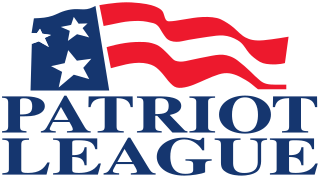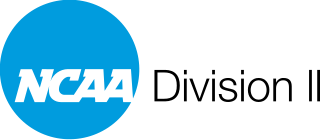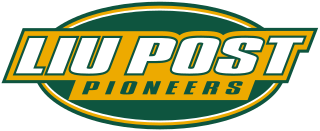
The National Collegiate Athletic Association (NCAA) is a nonprofit organization that regulates student athletics among about 1,100 schools in the United States, and one in Canada. It also organizes the athletic programs of colleges and helps over 500,000 college student athletes who compete annually in college sports. The organization is headquartered in Indianapolis, Indiana.

The Patriot League is a collegiate athletic conference comprising private institutions of higher education and two United States service academies based in the Northeastern United States. Except for the Ivy League, it is the most selective group of higher education institutions in NCAA Division I, and has a very high student-athlete graduation rate for both the NCAA graduation success rate and the federal graduation rate.

The Northeast Conference (NEC) is a collegiate athletic conference whose schools are members of the National Collegiate Athletic Association (NCAA). Teams in the NEC compete in Division I for all sports; football competes in the Division I Football Championship Subdivision (FCS). Participating schools are located principally in the Northeastern United States, from which the conference derives its name.

The South Atlantic Conference (SAC) is a college athletic conference affiliated with the National Collegiate Athletic Association (NCAA) at the Division II level, which operates in the southeastern United States. The SAC was founded in 1975 as a football-only conference and became an all-sports conference beginning with the 1989–90 season.

The National Association of Intercollegiate Athletics (NAIA) established in 1940, is a college athletics association for colleges and universities in North America. Most colleges and universities in the NAIA offer athletic scholarships to their student athletes. $1.3 billion in athletic scholarship financial aid is awarded to student athletes annually. For the 2023–24 season, it had 241 member institutions, of which two are in British Columbia, one in the U.S. Virgin Islands, and the rest in the continental United States, with over 83,000 student-athletes participating. The NAIA, whose headquarters is in Kansas City, Missouri, sponsors 28 national championships. CBS Sports Network, formerly called CSTV, serves as the national media outlet for the NAIA. In 2014, ESPNU began carrying the NAIA Football National Championship.

NCAA Division I (D-I) is the highest level of intercollegiate athletics sanctioned by the National Collegiate Athletic Association (NCAA) in the United States, which accepts players globally. D-I schools include the major collegiate athletic powers, with large budgets, more elaborate and nicer facilities and a few more athletic scholarships than Divisions II and III as well as many smaller schools committed to the highest level of intercollegiate competition.

The Atlantic Sun Conference (ASUN) is a collegiate athletic conference operating mostly in the Southeastern United States. The league participates at the NCAA Division I level, and began sponsoring football at the Division I FCS level in 2022. Originally established as the Trans America Athletic Conference (TAAC) in 1978, it was renamed as the Atlantic Sun Conference in 2001, and briefly rebranded as the ASUN Conference from 2016 to 2023. The conference still uses "ASUN" as an official abbreviation. The conference headquarters are located in Atlanta.

NCAA Division II (D-II) is an intermediate-level division of competition in the National Collegiate Athletic Association (NCAA). It offers an alternative to both the larger and better-funded Division I and to the scholarship-free environment offered in Division III.

College athletics in the United States or college sports in the United States refers primarily to sports and athletic training and competition organized and funded by institutions of tertiary education in a two-tiered system.

The Power Five conferences are the five most prominent athletic conferences in college football in the United States. They are part of the Football Bowl Subdivision (FBS) of NCAA Division I, the highest level of collegiate football in the nation, and are considered the most elite conferences within that tier. The Power Five conferences have provided nearly all of the participants in the College Football Playoff since its inception, and generally have larger revenue, budgets, and television viewership than other college athletic programs.
NCAA Division I independent schools are four-year institutions that compete in college athletics at the NCAA Division I level, but do not belong to an established athletic conference for a particular sport. These schools may however still compete as members of an athletic conference in other sports. A school may also be fully independent, and not belong to any athletic conference for any sport at all. The reason for independent status varies among institutions, but it is frequently because the school's primary athletic conference does not sponsor a particular sport.

In college athletics in the United States, recruiting is the process in which college coaches add prospective student athletes to their roster each off-season. This process typically culminates in a coach extending an athletic scholarship offer to a player who is about to be a junior in high school or higher. There are instances, mostly at lower division universities, where no athletic scholarship can be awarded and where the player pays for tuition, housing, and textbook costs out of pocket or from financial aid. During this recruiting process, schools must comply with rules that define who may be involved in the recruiting process, when recruiting may occur and the conditions under which recruiting may be conducted. Recruiting rules seek, as much as possible, to control intrusions into the lives of prospective student-athletes. The NCAA defines recruiting as “any solicitation of prospective student-athletes or their parents by an institutional staff member or by a representative of the institution’s athletics interests for the purpose of securing a prospective student-athlete’s enrollment and ultimate participation in the institution’s intercollegiate athletics program."

College lacrosse is played by student-athletes at colleges and universities in the United States and Canada. In both countries, men's field lacrosse and women's lacrosse are played at both the varsity and club levels. College lacrosse in Canada is sponsored by the Canadian University Field Lacrosse Association (CUFLA) and Maritime University Field Lacrosse League (MUFLL), while in the United States, varsity men's and women's lacrosse is governed by the National Collegiate Athletic Association (NCAA), National Junior College Athletic Association (NJCAA) and National Association of Intercollegiate Athletics (NAIA). There are also university lacrosse programs in the United Kingdom sponsored by British Universities and Colleges Sport (BUCS) and programs in Japan.

The TCNJ Lions are the athletic teams representing The College of New Jersey (TCNJ). They are a member of the New Jersey Athletic Conference (NJAC) and compete within Division III of the National Collegiate Athletic Association (NCAA).

The LIU Post Pioneers were the athletic teams that represented the C.W. Post Campus of Long Island University, located in Brookville, New York, in NCAA Division II intercollegiate sports through the 2018–19 school year. The Pioneers most recently competed as members of the East Coast Conference for most sports; the football team was an affiliate of the Northeast-10 Conference. LIU Post has been a member of the ECC since 1989, when the league was established as the New York Collegiate Athletic Conference.
NCAA Emerging Sports for Women are intercollegiate women's sports that are recognized by the National Collegiate Athletic Association (NCAA) in the United States, but do not have sanctioned NCAA Championships.















